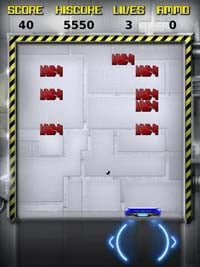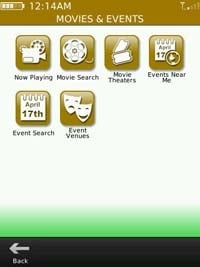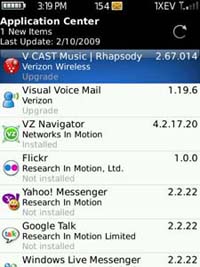
The Storm outperforms most BlackBerrys with its crisp, innovative touch-button screen. Boasting a 3.2 megapixel auto-focus still and video camera, the Storm impresses by packing numerous features into its sleek and sturdy form-factor. There is a lot to like about this device, including its sharp display, a camera, and applications like Visual Voicemail, but there are still some glaring problems.
RIM BlackBerry Storm 9530 full specifications with in-depth details. Even after updating its operating system with Verizon's new patch, there is still lag present in a lot of applications which hinders the phone's functionality in many areas. And the lack of Wi-Fi and QWERTY keyboard, and unrelenting fingerprints detract from the innovative hardware. There are issues that Verizon and RIM will be able to address via further firmware updates, but there are others (read: lack of Wi-Fi) that can only be incorporated into future Storm versions.
Touchscreen smartphones are certainly a big hit right now. If you consider Apple’s ever-popular iPhone, HTC’s well-received Touch lineup, and many others, touch is a high-demand feature. Manufacturers are certainly taking note of this fact. Traditionally speaking, the BlackBerry line of smartphones share a common layout with a QWERTY keyboard located beneath a standard (i.e. non-touchscreen) display.
Considering the popularity of touch, you can imagine that Research in Motion wasn’t going to hold out on creating a touchscreen device forever. As to be expected, the company received a lot of hype when it announced the first ever touchscreen BlackBerry smartphone in October of last year. But as the BlackBerry Storm 9530 officially hit the scenes late last year, it was met with mixed reviews.
We’ve been checking out Verizon Wireless’ version of this smartphone for over a month now. Instead of rehashing the same stuff that you’ve seen in other reviews, we’re going to look at this BlackBerry in terms of how it is different from other smartphones (not just other BlackBerries), and how well it will meet the needs of both business and personal users. In light of the fact that Amazon is now offering the Storm for just $99, it’s also important to consider what you’ll get for the money.

The BlackBerry Storm’s clickable touchscreen is what sets the Storm apart from other touchscreen devices we’ve seen to date. We’ll discuss interactions with this screen more later, but it’s important to keep in mind that you must touch the screen to select a command and then press the screen to “click.” Other touchscreen devices simply require a single tap of a finger or stylus to initiate an action.
Research in Motion took its experience in producing business-centric devices and has incorporated many of the company's well-liked and well-known organizational and communication features into the BlackBerry Storm. Because you interact with the Storm in a manner that is unlike any other BlackBerry to date, the new interface affects the way the way applications look and feel. However, the changes are minor so most BlackBerry users will still feel right at home. In the end, some users will welcome the change while others may dislike the new interface. In addition to traditional business applications and features, the BlackBerry Storm also incorporates a number of consumer-friendly features, including a camera, application store, GPS receiver, and media player/manager. Read on as we discuss more about this rather interesting smartphone. BlackBerry Storm 9530 mobile phone review, specifications and price check. The ultimate catalog for mobile phones, smartphones and PDA news, reviews.
Specifications
- Dual–band 800/1900 MHz CDMA/EV–DO Rev. A networks; Quad–Band: 850/900/1800/1900 MHz GSM/GPRS/EDGE networks; Single–Band: 2100 MHz UMTS/HSPA networks
- Global SIM Card preinstalled
- 128MB Flash Memory, 192MB RAM, 1GB on–board memory
- microSD memory card slot with 8GB SanDisk card installed (device supports up to 16GB)
- 4.43 x 2.45 x 0.55 inches (HxWxD)
- Approximately 5.47 oz. including battery
- Standard Lithium Cell (1400 mAh)
- Up to 270 minutes of talk time
- Up to 372 hours in standby
- 3.25-inch color TFT LCD (480x360 pixel) with support for over 65k colors
- 3.2MP camera w/flash, autofocus, and video capture
- Integrated speaker and microphone
- Media Player
- Bluetooth v2.0 including A2DP for Stereo sound
- SurePress touchscreen with portrait and landscape views
- SureType and multi–tap onscreen / virtual keyboards in portrait mode; QWERTY virtual keyboard in landscape mode
- BlackBerry 4.7 Desktop Software with integrated Email, Phone, SMS, Browser, Calendar, Address Book, and additional organizer applications
- BlackBerry Internet Solution (BIS) which can integrate up to 10 personal email accounts
- BlackBerry Enterprise Solution (BES) – works to provide functionality such as single mailbox integration, remote address book look up, and more
- Polyphonic + vibrate ring tones
- Text, Picture, Video, and Instant Messaging
- VZ Navigator
- Visual Voice Mail compatible
- Mobile Broadband Connect capable (Windows only)
- Instant Messaging applications for BlackBerry
- V CAST Music with Rhapsody (Subscription, Wireless, & PC downloads)
- Password protection and keyboard lock
In the box:
- 1400mAh Lithium Ion Battery
- 3.5 mm Stereo Headset
- BlackBerry Travel Charger with International Adaptor Clips
- USB Data Cable
- 8GB SanDisk microSD memory card (preinstalled)
- SIM Card (preinstalled)
- Documentation Kit (including BlackBerry Tools CD)
- VZAccess Manager CD (including User Guide)
- Quick Reference Guide
- Global Support Kit
Desaign
At first glance, the BlackBerry Storm is likely to remind you of other BlackBerry devices, but without a QWERTY keyboard. The front of the device has a high-gloss finish that looks good, but tends to attract fingerprints. Even the four hardware buttons (send, menu, escape, and end/power) at the base of the display tend to show some fingerprints. Thankfully, we didn’t notice a degradation in performance when the screen was fingerprinted.




Interface
As we hinted up on earlier, the BlackBerry Storm uses a clickable touchscreen display. The phone also has a built-in accelerometer that automatically rotates the screen’s display whenever you turn the device on either side. Unlike some phones which have very limited accelerometer functionality, the Storm's accelerometer will rotate the display in most applications.
The clickable touchscreen display takes a little getting use to, especially if you’re accustomed to using a traditional touchscreen device. First, you must touch the area of the screen to select a command or button. Then, once the command is highlighted, you must press the screen to invoke the command. (You don’t have to lift your finger from the screen once an item is selected, and the control eventually becomes very quick and automatic.) This control method works pretty well whenever there is a large icon, but in instances where there’s a long list of clickable items (such as in the BlackBerry Help screen), it’s easy to select an item and then accidentally change the selection before you click the screen. I have relatively small hands, but even so, there were also plenty of times where my hand and fingers would block my view of what was selected.
When browsing the Internet, touching the screen quickly (touch, not click) will zoom in on a page. To zoom out, you can press the escape hardware button. Zooming in is very helpful for reading text as well as when attempting to select clickable items.

To scroll in any scrollable screen such as a webpage, email, or document, you simply flick your finger across the screen just as you would with the iPhone or another touchscreen device with similar functionality.
Whenever you need to type, the Storm displays one of three keyboards automatically based on the field you are typing in and the orientation of your device. In portrait mode, you can switch between the SureType Technology keyboard and the multi-tap keyboard. Both keyboards combine more than one letter on each key. The SureType keyboard combines two letters onto each key and uses a QWERTY layout. SureType will predict words as you type them. As its name implies, you must tap the multi-tap keyboard multiple times to type a desired letter. For example, to type the second letter on the key, you must press that key twice. In landscape mode, the phone will display a full keyboard that uses a traditional QWERTY layout with one letter on each key.
Made For your LifeStyle
Often, smartphones are significantly slanted towards either business or consumer use. The BlackBerry Storm offers a good blend of both, making it perfect for the business user who wants a fun device or the general consumer who wants serious organizational and email functionality along with multimedia capabilities. The phone offers standard organization functions as well as a variety of communications technologies to keep the business user connected to the office. It also offers plenty of multimedia features for entertainment as well.
Business users will appreciate that the phone incorporates BlackBerry’s renowned email capabilities. The Storm also supports BlackBerry Enterprise Server for over-the-air synchronization with business accounts. Any time you need to edit a Microsoft Word, Excel, and PowerPoint file, you’ll be able to do so from the device thanks to DataViz’ Documents To Go. With 1GB of on-board memory and an 8GB microSD flash card, there is plenty of storage space for all of your important documents as well as numerous multimedia files.
The Storm can also serve as a high-speed modem to provide Internet access on your laptop. Because the phone supports Verizon Wireless’ Global Phone and Global Email services, you’ll stay connected regardless of your location.
When you’re off the clock and ready for some downtime, the Storm’s media player lets you watch movies and view pictures and slideshows in full-screen mode. There’s also a 3.2MP camera with video recording capabilities, flash, variable zoom, and image stabilization to help you capture memories. The camera takes pretty decent pictures, though serious photographers will still appreciate the optics found only in a standalone camera.
Email doesn’t have to be strictly for business on the Storm. In addition to catering to business emailaccounts, the Storm has no problem connecting to a variety of personal email accounts from providers such as Yahoo!, Gmail, or Hotmail. Setup is relatively easy, as well: In just a few taps, we had a Hotmail account set up on the device with an icon to access the messages directly from the home screen.
BrickBreaker and Word Mole are the only two games that are preloaded on the device. A popular game that many users are sure to recognize, BrickBreaker makes use of the phone’s clickable touchscreen, allowing you to click to launch a ball and then slide your finger across the screen to move the paddle.
Word Mole may remind some people of a spin-off of a crossword puzzle. The object of the game is to form words using the letters that are found in a “garden.” As you form words, new letters appear. To challenge you, “holes” will appear within the garden as dead spaces that make it harder to form new words. You must complete a certain number of words in order to move on to the next level before the time expires.
The Storm also features VZ Navigator with traffic data to help you find your way to a meeting or entertainment spot. While navigating, the software provides turn by turn voice instructions with spoken street names. VZ Navigator also offers local search capabilities as well as movie and event listings and weather reports.
Many of the applications within the Application Center target consumers. Here, you’ll find download links to install applications such as V CAST music, Flickr, Yahoo! Messenger, Google Talk, Windows Live Messenger, AOL Instant Messenger, MySpace, and Facebook. Once these applications have been installed, you’ll find them by opening the Applications icon from the main menu.
Performance & Conclusion
During our tests, there were a few instances in which the phone appeared sluggish. There were also times in which we tapped and clicked an onscreen button and received no response. After tapping and clicking once or twice, the device generally responded. It’s hard to say what caused these issues. The Storm has already received a few over the air updates. Some of these updates seem to have resolved a few issues, but some still remain. It’s possible the company could release future updates that would solve the problems, though Research in Motion hasn't made any announcements in that regard.
Even with the few issues we experienced with the touchscreen and an occasionally sluggish device, the problems were not common enough to prevent us from using the device all together. In fact, the large majority of the time, the device worked perfectly and we didn’t experience any of these issues.
Call quality while talking on the Storm was very good. The phone's speaker was adequate as well, and the "feet" that are on either side of the device make a positive difference when you set the phone on a desk during a conversation using the speakerphone feature.
Because the Storm builds upon the popular BlackBerry interface, anyone who has used a BlackBerry device in the past should feel comfortable with the Storm. Even though it has a different form factor than previous BlackBerries, the Storm offers many features and input options that you may already be familiar with, such as the SureType keyboard. For users who desire tactile feedback when entering data on a phone, the Storm’s clickable touchscreen definitely provides a noticeable response.
Battery life on the Storm was acceptable. There were days where we was able to use the device throughout the day and for part of the next day without charging it. Of course, your experiences will vary depending on how much you use the phone’s data, GPS, Bluetooth, and voice capabilities.
We have yet to see a perfect smartphone that is always 100% responsive and quick to action. Despite a few glitches here and there in terms of the phone’s performance, the Storm is an acceptable device overall. We like the fact that Research in Motion has struck a balance between business and consumer use.
The saying, “If it’s not broken, don’t fix it” definitely applies to the BlackBerry Storm’s interface. For years, Research in Motion has enjoyed great success with its BlackBerry operating system and user controls. Thankfully, the company stuck with what it knew and didn’t try to overhaul the device in order to make it work with a touchscreen. Instead, the company utilized similar menus and controls as are used in other BlackBerry devices and simply added touch controls.
Considering the Storm is a first-generation touch screen BlackBerry, the company executed fairly well on this first effort. We’re anxious to see how Research in Motion takes what they’ve learned from developing and marketing the Storm and incorporates those lessons into future devices. BlackBerry Storm 9530 Price in India, BlackBerry Storm 9530 Features, BlackBerry Storm 9530 Specifications, BlackBerry Storm 9530 Review. The Storm 9530 is part of the cell phone & service test program at Consumer. Blackberry storm 9530 was released yesterday, so i check the specifications about that. BlackBerry Storm 9530 Reviews | Smartphones | Review Centre.
At the time this article was published, Verizon Wireless offers the phone for $199.99. And as we mentioned earlier in this article, some outlets are selling the Storm for less.
BlackBerry Storm 9530 Price
The best price of Blackberry Storm 9530 in India is Rs. 11990. The price has been sourced from 9 online stores in India as on 18th March 2011. Click Here [Via eBay]





















0 comments:
Post a Comment